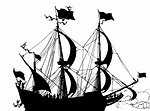400th Anniversary of Hudson’s Historic Voyage
The 85-foot Dutch ship Half Moon sailed up the Hudson River nearly to Albany in September 1609 in search of a northwest passage to Asia. This year New York State celebrates that voyage as well as Champlain’s 1609 discovery of the lake named after him and Fulton’s initial 1807 steamboat journey on the Hudson.
I became aware that this was not the first but the third voyage by Hudson when I read Donald Johnson’s Charting the Sea of Darkness: The Four Voyages of Henry Hudson, which, along with other books on him and the Hudson River, is available through our Library. Sponsored by an English society, Hudson’s first and second voyages were in search of a northeast passage to Asia by way of the north of Europe, but he could not find passages through thick sea ice. This is not surprising since it was undertaken during what is known as the Little Ice Age. (It took the advent of nuclear-powered icebreakers before that route could be navigated.)
While English investors were disappointed in Hudson’s failure to find an open route to the riches of the Orient, the Dutch East India Company, England’s greatest trading rival, funded his third voyage in 1609 with the stipulation that it too would be to the northeast. After sailing up the coast of Norway and experiencing ice blocking his passage, he abandoned that route and turned westward to the New World seeking a north-west passage. He explored the coast of North America from Nova Scotia and Maine down to Chesapeake and Delaware bays. Hudson’s voyage took place two years after the settlement of Jamestown, Virginia, and well before that at Plymouth, Massachusetts. Hudson’s ship entered the river that would bear his name on September 10 sailed upriver to present-day Albany then departed New York harbor for Europe 24 days later. He returned to England instead of Holland where he was arrested for sailing under another nation’s flag. Some have suggested that Hudson was acting as an English spy to get Dutch maps. On his fourth voyage, which was sponsored by English adventurers in 1610, he discovered Canada’s Hudson Bay but perished when his crew mutinied and set him adrift in a small boat.
Hudson’s explorations led to the founding of New Netherlands, which included New Amsterdam on Manhattan Island and sites on the Delaware and Housatonic rivers. Surprisingly, the first Dutch settlement was not New Amsterdam but Fort Nassau on Castle Island near Albany in 1615. While New Netherlands capitulated to England in 1664, Dutch influence continued long afterward.
While 17th Century Dutch documents have been in the possession of New York State for more than a century, the Dutch language, being very different from that of today, hampered their translation into English. Dr. Charles Gehring, however, learned this older language. Over the last several decades he translated huge numbers of documents as the Director of the New Netherlands Project of New York State. They are now regarded as a national treasure. Russell Shorto’s popular book The Island at the Center of the World: The Epic Story of Dutch Manhattan and the Forgotten Colony that Shaped America is based on Gehring’s translations. He and Gehring paint a much different picture of the Dutch and their contributions than English writers historically have. A chronology of the Dutch discovery and settlement is available at www. newnetherland.org and www.ianchadwick.com/hudson/
The Palisades Free Library will celebrate Hudson’s voyage and the important role ships on the Hudson River played with two programs. On Sunday, September 12, historian Charles Stark of Marist College and the Hudson River Institute will speak at the Esplanade on The Mystery of Hudson’s Voyage of Discovery. Among other things he will explore why Hudson returned to England instead of Holland. On the preceding day various exhibits and short talks by long-time residents will take place at the Library. More details will follow in the next issue of 10964.


